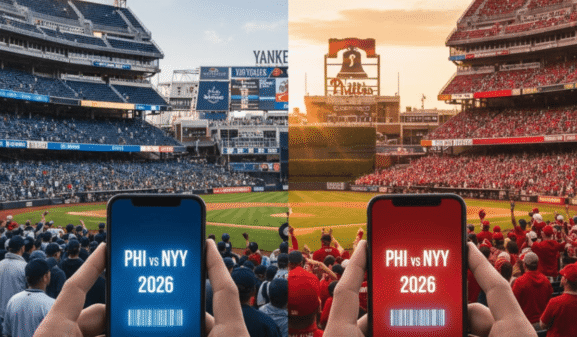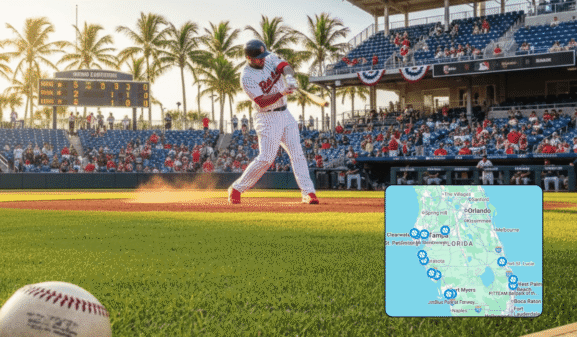MLB Top 100 Prospects 2025: Complete Rankings and Analysis
Baseball’s future is brighter than ever, with an incredible wave of young talent making their mark across Minor League Baseball. The latest MLB Top 100 Prospects rankings showcase a dynamic mix of established phenoms, breakout stars, and fresh faces from the 2025 Draft, creating one of the most compelling prospect landscapes in recent memory.
The updated rankings reflect significant movement following a full season of development, strategic trades, and the injection of new talent from this year’s draft class. From Konnor Griffin’s continued dominance atop the rankings to surprising risers like Luis Peña, these prospects represent the next generation of baseball superstars ready to reshape the Major Leagues.
Current Top 100 MLB Prospects Rankings
Data source: MLB.com Minor League Baseball
Breaking Down the Elite Top 10
The cream of the crop remains largely unchanged at the summit, though several prospects have made impressive moves within the elite tier. Konnor Griffin maintains his stranglehold on the #1 position, cementing his status as baseball’s premier prospect after being selected ninth overall by Pittsburgh in 2024.
Griffin’s combination of five-tool potential at the premium shortstop position makes him a generational talent. At just 19 years old, he’s shown remarkable improvement in his hit tool since turning professional, complementing his already impressive plus power potential and plus-plus speed. His development trajectory suggests he could be fast-tracked to the majors sooner than initially anticipated.
Kevin McGonigle’s rise to #2 represents one of the year’s most significant success stories. The Tigers’ shortstop has demonstrated arguably the best hit tool in the minors, maintaining a career .319 batting average that showcases his advanced approach at the plate. His consistent performance has elevated him from a promising prospect to a can’t-miss talent.
Leo De Vries at #3 brings an interesting storyline as the Athletics’ first Top 10 prospect since MLB Pipeline began rankings in 2004. Acquired from San Diego in the Mason Miller trade, De Vries possesses wicked bat speed as a switch-hitter, providing Oakland with a cornerstone piece for their rebuild.
The presence of two Pirates prospects in the top 10 (Griffin and Bubba Chandler at #7) highlights Pittsburgh’s impressive prospect development, while Sebastian Walcott’s inclusion demonstrates Texas’s ability to identify and develop premium talent at challenging positions.
Notable Newcomers Making Waves
The most compelling aspect of the updated rankings is the emergence of 29 players who weren’t considered top-100 material at the season’s start but have forced their way into consideration through exceptional performance.
Luis Peña leads this group at #16, representing the biggest success story among non-drafted additions. The Brewers infielder made an immediate impact after skipping to Single-A at 18, posting a .301/.374/.471 slash line with seven home runs and an impressive 14.0% strikeout rate across 76 games. His rapid promotion to High-A demonstrates Milwaukee’s confidence in his advanced skill set.
Carson Benge (#20) gives the Mets another impact outfield prospect, while George Lombard Jr. (#25) adds to the Yankees’ deep farm system. The presence of multiple newcomers in the top 30 speaks to the overall depth of talent currently developing in professional baseball.
Draft Class Integration and Impact
The 2025 Draft class has made a significant early impression, with 12 selections cracking the top 100 despite limited professional experience. While this year’s class may lack the immediate star power of Paul Skenes’ 2023 debut at #3, it demonstrates remarkable depth and potential for long-term impact.
Ethan Holliday leads the draft class at #17, giving Colorado a potential franchise cornerstone at shortstop. The fourth overall pick brings an impressive combination of hitting ability and defensive skills that could accelerate his development timeline.
First overall selection Eli Willits (#18) provides Washington with a premium middle infield talent, while Kade Anderson (#22) gives Seattle a left-handed pitching prospect with frontline potential. The distribution of draft picks throughout the rankings suggests this class could have staying power as these players develop.
Biggest Risers and Development Success Stories
The year’s most dramatic individual success story belongs to Josue Briceño, whose 63-spot jump from #95 to #32 represents exceptional development. The Tigers’ first baseman/catcher built on his Arizona Fall League Triple Crown performance with continued excellence in his age-20 season, demonstrating both power and average that could translate quickly to the majors.
Trey Yesavage’s 62-spot rise (#88 to #26) showcases the Blue Jays’ pitching development program, while Zyhir Hope’s 56-spot jump (#75 to #19) adds another dynamic outfield talent to the Dodgers’ loaded system.
Perhaps most impressively, Jesús Made’s 51-spot surge from #56 to #5 demonstrates how quickly young international talent can accelerate their development. At just 18 years old, Made has already reached High-A, making him younger than many high school picks in this year’s draft while showing advanced skills that suggest a rapid path to the majors.
Organizational Farm System Strength
The distribution of prospects across all 30 organizations reveals interesting trends in player development and organizational philosophy. The Pirates’ presence with two top-10 prospects (Griffin and Chandler) demonstrates their commitment to rebuilding through youth, while the Dodgers continue to showcase their international scouting and development prowess.
Teams like Detroit, Milwaukee, and Seattle have multiple prospects making significant jumps, suggesting strong development programs that maximize player potential. The Athletics’ acquisition of De Vries and development of prospects like Gage Jump (#58) shows how strategic trades can quickly transform organizational prospect depth.
Future Outlook and Major League Impact
The current prospect landscape suggests an incredibly exciting future for Major League Baseball. With talents like Griffin, McGonigle, and De Vries leading the way, fans can expect an influx of dynamic, multi-tool players who will reshape how the game is played at the highest level.
The depth of hitting talent throughout the rankings, combined with emerging pitching prospects like Chandler, Andrew Painter, and the 2025 draft class, creates a perfect storm of talent that should provide years of compelling baseball. Organizations that have invested heavily in player development are beginning to see those investments pay dividends.
The integration of international talent like Made and Peña also highlights baseball’s global reach and the incredible skill level being developed worldwide. As these players continue their development, they represent not just individual success stories but the evolution of baseball as a global sport.
Conclusion
The MLB Top 100 Prospects rankings provide a fascinating glimpse into baseball’s future, showcasing an unprecedented level of talent across all positions and skill sets. From Konnor Griffin’s five-tool dominance to the depth of emerging talent throughout the system, the current prospect landscape promises years of exciting baseball ahead.
The combination of established prospects taking the next step in their development, surprise breakout performers, and an impressive draft class creates one of the most compelling prospect environments in recent memory. Organizations that have prioritized player development and international scouting are reaping the benefits, while fans can look forward to watching these talents transition to the major leagues.
As the season progresses and these prospects continue their development, the rankings will undoubtedly see more movement. However, the current top 100 provides a strong foundation for understanding which young players are most likely to impact the major leagues in the coming years, making now an exciting time to follow baseball’s future stars.
Read also: 2025-26 MLB Free Agents: Complete Player Guide by Position
Frequently Asked Questions (FAQ)
Q: How often are MLB Top 100 Prospects rankings updated?
A: MLB Pipeline typically updates their Top 100 rankings multiple times per year, including preseason rankings, midseason updates after the draft and trade deadline, and additional updates based on player performance and development.
Q: What criteria are used to evaluate prospects for the Top 100?
A: Prospects are evaluated based on current skill level, ceiling potential, floor projections, and proximity to the major leagues. Factors include hitting ability, power, speed, fielding, arm strength, and for pitchers, velocity, command, and pitch repertoire.
Q: Can drafted players immediately enter the Top 100?
A: Yes, exceptional draft picks can enter the rankings immediately based on their amateur performance and projected professional ceiling. However, most prospects need professional experience to establish their ranking position.
Q: What happens when a prospect graduates to the major leagues?
A: Once a prospect exhausts their rookie eligibility (130 at-bats or 50 innings pitched in the majors), they typically graduate from prospect lists, making room for emerging talent.
Q: Which positions are most valued in prospect rankings?
A: Premium defensive positions like shortstop, catcher, and center field are highly valued, as are starting pitchers. However, exceptional talent at any position can reach the top of the rankings.
Q: How accurate are prospect rankings at predicting major league success?
A: While no ranking system is perfect, top prospects have historically shown higher success rates in reaching and succeeding in the major leagues compared to lower-ranked or unranked players.
Q: Do international prospects compete equally with drafted players?
A: Absolutely. International prospects like Jesús Made and Luis Peña demonstrate that talent from around the world can quickly rise through the rankings based on performance and potential.
Q: What role do injuries play in prospect rankings?
A: Injuries can significantly impact rankings, either through reduced playing time affecting development or concerns about long-term health and durability affecting future projection.


